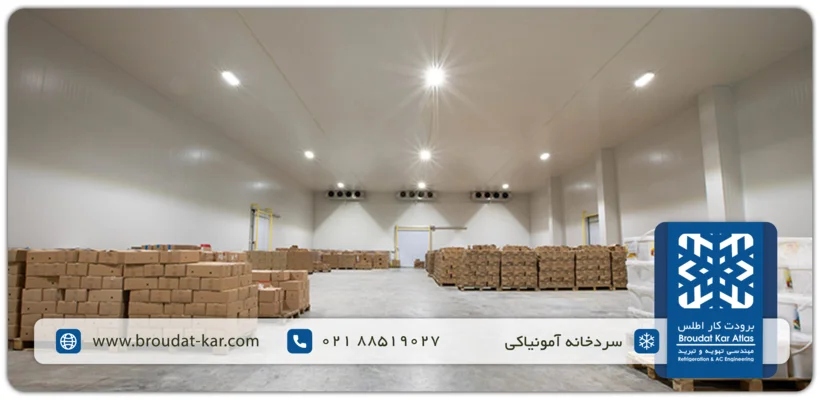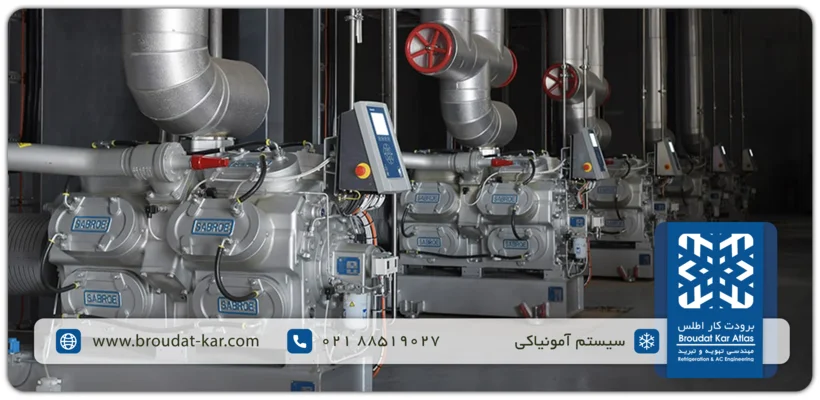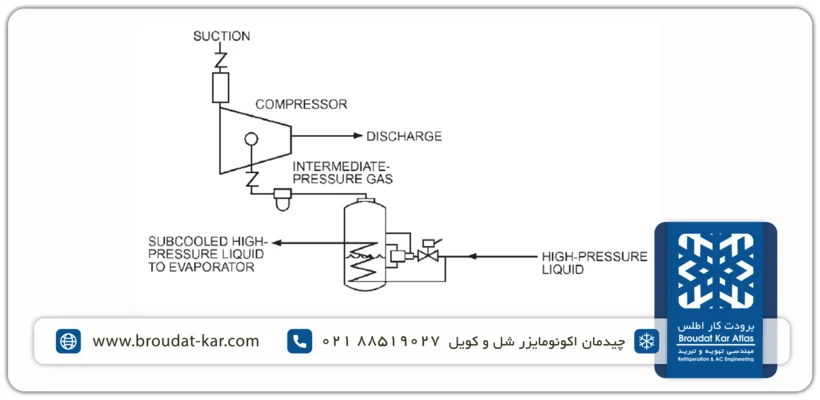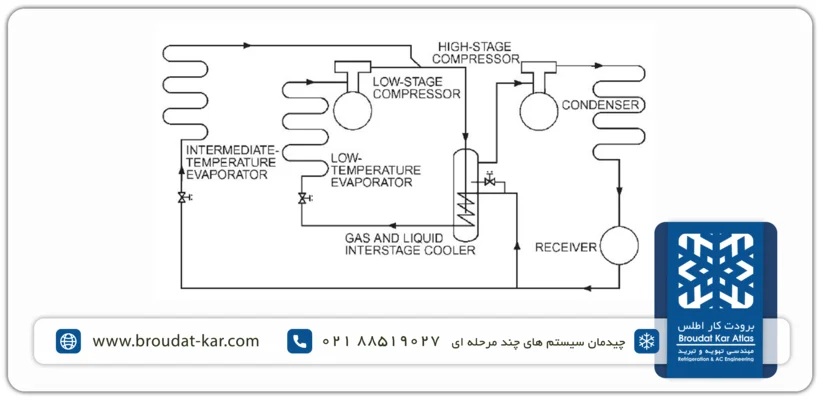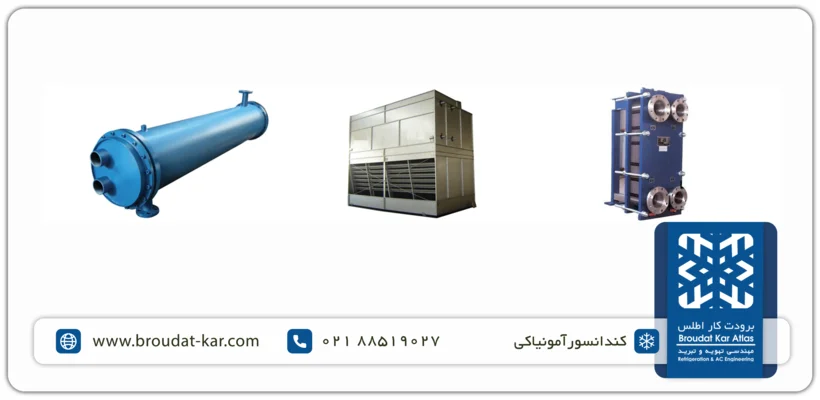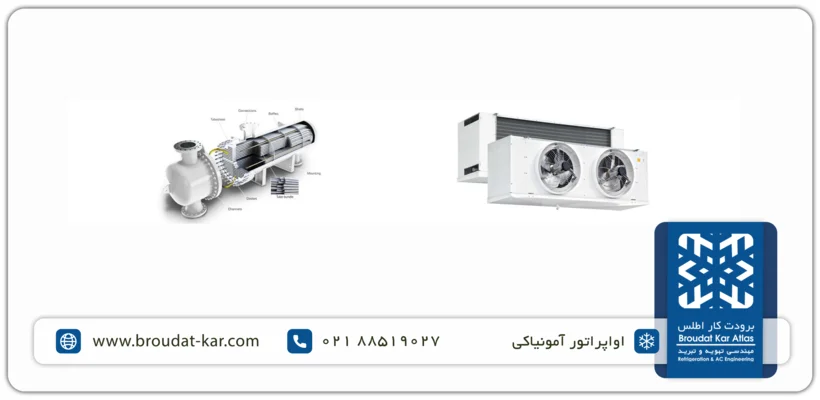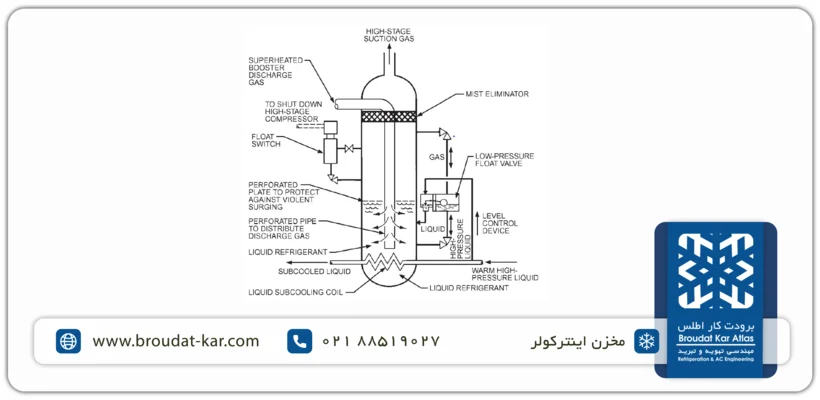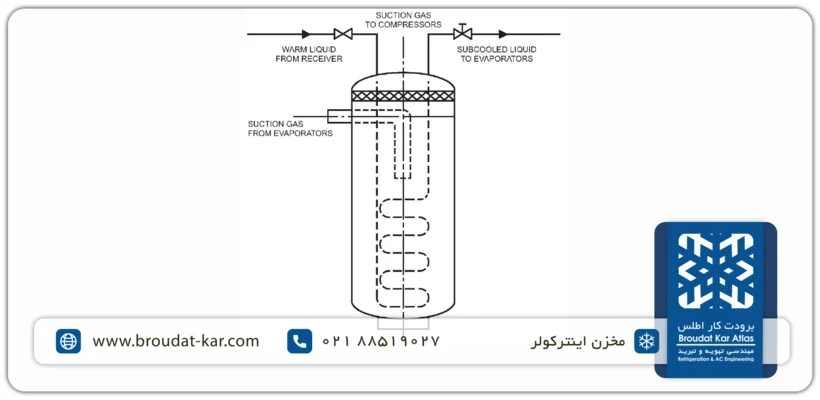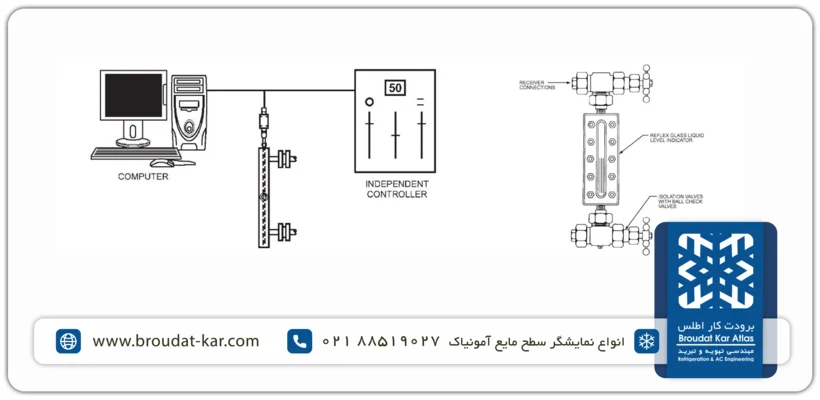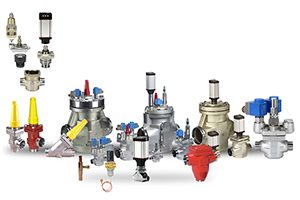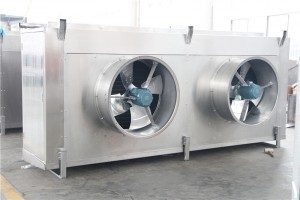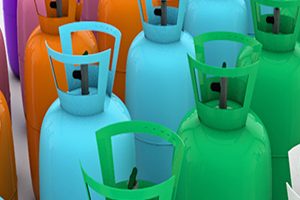Introduction to Ammonia Refrigeration Systems – Properties, Applications, and Equipment Overview
Ammonia, with the chemical formula NH3 and the refrigerant code R-717, is a colorless substance characterized by a pungent odor. Composed of nitrogen and hydrogen, it is lighter than air, boasting a density of approximately 0.771 kg/m^3—almost half that of air. Its strong hydrogen bonding allows for an easy transformation into a liquid state. Ammonia undergoes liquefaction at -33 degrees Celsius under a pressure of 1 atmosphere, necessitating pressurized vessels for storage. This exceptional property makes it an ideal choice as a refrigerant.
Compatibility and Transport
Ammonia exhibits compatibility with all common materials except copper and brass. Typically, steel pipes with welded connections are employed for ammonia lines, although stainless steel pipes find application in certain cases. In instances involving hermetic compressors, the use of aluminum or coated-wire aluminum is recommended. Ammonia does not dissolve in common refrigeration oils, and its lighter nature augments the efficiency of the oil return system.
Environmental Considerations
As a natural refrigerant, ammonia carries no adverse effects on ozone layer depletion or global warming. Its remarkable efficiency positions ammonia as one of the most environmentally friendly refrigerants available.
In the subsequent sections, we will delve into the advantages, applications, and various considerations associated with Ammonia Refrigeration Systems.
Embracing sustainability: Ammonia cold storage offers an eco-friendly solution, safeguarding product quality while minimizing environmental impact and mitigating global warming.
Ammonia as an Efficient Refrigerant
Ammonia stands out as one of the most acknowledged and efficient refrigerants, particularly in large-scale industrial refrigeration systems. Its highly desirable thermodynamic properties contribute to superior performance, often surpassing that of synthetic gases (freons), leading to heightened overall efficiency. Despite these advantages, the commercial use of ammonia on a smaller scale has been restricted due to drawbacks such as incompatibility with certain materials, toxicity, and flammability.
Theoretical Efficiency and Practical Performance
Theoretically, ammonia is deemed to offer higher efficiency compared to gases like R404a and R-134a. However, practical evidence suggests that ammonia-based systems not only meet but also exceed these theoretical calculations. This real-world performance reinforces the reputation of ammonia as an exceptionally efficient refrigerant.
Cost-Effectiveness and Availability
Ammonia proves to be a highly cost-effective refrigerant, especially when compared to freons such as R-22. In concrete terms, ammonia gas is approximately 30 times cheaper per kilogram than the least expensive freon available. Moreover, its ready availability in the Middle-east enhances its appeal as an economical and efficient refrigerant option.
Advantages of Employing an Ammonia Refrigeration System:
Capital Cost Savings
The investment required for an industrial refrigeration system utilizing ammonia is notably 10% to 20% lower compared to systems employing other refrigerants. This cost reduction stems from the ability to choose fewer compressors with higher capacity, coupled with the advantage of employing smaller-sized pipes in ammonia refrigeration systems.
Higher Efficiency
Ammonia exhibits a superior efficiency range, approximately 3% to 10% higher than other chlorofluorocarbon (CFC) gases. This heightened efficiency translates into reduced power consumption and operational costs, making ammonia-based systems more resource-efficient.
Environmental Safety
Ammonia stands out for its exceptional environmental safety, boasting an Ozone Depletion Potential (ODP) and Global Warming Potential (GWP) of 0. Its eco-friendly profile makes it a responsible choice in line with sustainable practices.
Cost-Effectiveness
The economic advantage of using ammonia as a refrigerant is underscored by its significantly lower cost compared to chlorofluorocarbon (CFC) and hydrochlorofluorocarbon (HCFC) freons. Ammonia gas emerges as a cost-effective solution in the realm of refrigeration.
In conclusion, the adoption of an ammonia refrigeration system not only brings about substantial economic benefits but also aligns with environmental considerations. The amalgamation of cost-effectiveness and environmental safety positions ammonia as an excellent choice for diverse industrial applications.
Utilization of Compressors in Ammonia Gas Systems
In ammonia gas systems, industrial compressors take center stage, offering a markedly prolonged lifespan when juxtaposed with hermetic and semi-hermetic counterparts. Adhering to diligent maintenance protocols ensures that these systems can operate seamlessly for extended periods, underscoring their durability and reliability.
Challenges Associated with Ammonia Utilization:
While ammonia boasts various advantages, it is essential to acknowledge certain drawbacks linked to its application:
Incompatibility with Copper
The use of copper pipes and fittings is precluded in ammonia systems due to incompatibility issues. Alternative materials, such as steel or stainless steel, are favored to ensure system integrity.
Toxicity and flammability Concerns
Ammonia can exhibit toxicity at elevated concentrations. However, its distinctive strong odor serves as an effective preventive measure, allowing for easy detection and management before reaching hazardous levels. Additionally, the gas’s propensity to ascend in case of leaks ensures dissipation into the atmosphere, minimizing potential risks.
Diverse Applications of Ammonia Systems
The versatility of industrial ammonia refrigeration systems renders them indispensable in various sectors, encompassing:
Ammonia Refrigeration Warehouses
These specialized facilities leverage ammonia systems for efficient cooling, ensuring optimal storage conditions for perishable goods.
Ammonia Freezing Tunnels
Employed in quick-freezing processes, these tunnels utilize ammonia for its exceptional refrigeration properties.
Ice Bank Systems
Ammonia plays a pivotal role in systems dedicated to ice production and storage, finding applications in arenas like ice rinks and related industries.
Gas Distillation and Separation Plants
Industries requiring precise gas distillation and separation processes benefit from the reliability and efficiency of ammonia systems.
Oil, Gas, and Petrochemical Industries
Ammonia proves instrumental in cooling processes within these sectors, contributing to the overall efficiency and safety of operations.
Beverage Production Industries
From soft drinks to dairy products, the consistent and cost-effective cooling provided by ammonia systems is instrumental in beverage manufacturing.
Food Processing Plants
Ammonia finds application in various facets of food processing, including slaughterhouses, ice cream factories, fisheries, and more ensuring optimal conditions for production and storage.
Industrial Fishing Vessels
Ammonia systems cater to the unique refrigeration needs aboard industrial fishing vessels, preserving the freshness and quality of harvested seafood.
Versatility of Ammonia Refrigeration Systems
Ammonia refrigeration systems stand out for their adaptability, operating seamlessly across a spectrum of design conditions to meet diverse temperature requirements. For instance:
Freezing Food Materials
These systems excel in freezing food materials, maintaining a temperature range spanning from -45 to +10 degrees Celsius. This capability ensures the preservation of food products with optimal freshness.
Chocolate Storage Cold Room
Specifically designed for storing chocolate, these cold rooms maintain a temperature around +15 degrees Celsius, coupled with precise humidity control. This meticulous environment safeguards the integrity of chocolate products.
Meat Chilling Room
Addressing the unique needs of meat storage, ammonia refrigeration systems create a chilling room with a temperature range of +2 to +1 degree Celsius, accompanied by high humidity. This setup preserves the quality and freshness of meat products.
Industrial Cold Storage Facility
Catering to product distribution complexities, these facilities leverage ammonia systems to create distinct temperature zones. This versatility accommodates the storage of various products, including ice cream, frozen food, and meat. Moreover, it facilitates the seamless execution of production and trading processes on the dock.
Icemaker including Flake and Block types
Ammonia refrigeration is instrumental in the production of ice, providing an icemaker with the flexibility to create both flake and block at a temperature of -20 degrees Celsius. This adaptability suits diverse applications, from beverage cooling to industrial processes.
Chemical Processes
Ammonia finds application in chemical processes requiring precise temperature control, operating efficiently in a temperature range from -50 to +15 degrees Celsius. This makes it an ideal choice for industries where temperature-sensitive chemical reactions are paramount.
In essence, the inherent qualities of ammonia as a refrigerant, coupled with meticulous design and engineering, position it as the optimal solution for a wide array of industrial refrigeration needs.
Distinguishing Ammonia and Freon Refrigeration Warehouses
The disparity between ammonia and freon refrigeration warehouses extends beyond the choice of refrigerant, encompassing fundamental distinctions in their system configurations. Ammonia refrigeration systems traditionally opt for open-drive compressors and evaporative condensers, setting them apart from their freon counterparts, which predominantly feature hermetic (sealed) and semi-hermetic compressors coupled with air-cooled condensers.
Compressor Mechanisms
-Ammonia Systems: Embrace open-drive compressors coupled to electric motors, transferring the motor’s heat to the surrounding environment.
-Freon Warehouses: Primarily adopt hermetic and semi-hermetic compressors, directing a significant portion of the motor-generated heat into the refrigeration system rather than dispersing it externally.
Condenser Types
-Ammonia Systems: Employ evaporative condensers, which facilitate heat dissipation through water evaporation. This design contributes to an efficient heat exchange process.
-Freon Warehouses: Rely on air-cooled condensers, where heat dissipation is contingent upon the dry bulb temperature. This stands in contrast to water-cooled condensers used in ammonia systems, operating at temperatures proximate to the wet bulb temperature. The outcome is a system with lower condenser pressures, enhancing overall efficiency.
Understanding these distinctions is pivotal in comprehending the nuanced engineering choices between ammonia and freon refrigeration systems. Each configuration carries its unique advantages and considerations, contributing to the diverse landscape of industrial refrigeration solutions.
Ammonia in HVAC Systems: A Sustainable Alternative
Ammonia is experiencing a resurgence in HVAC (heating, ventilation, and air conditioning) systems, driven by the phase-out of certain refrigerants and rising costs of traditional options like CFC and HCFC. Despite not being directly suitable as an HVAC refrigerant, ammonia proves versatile by integrating secondary refrigerants such as chilled water or ethylene glycol. This well-established model provides a reliable alternative to conventional freon HVAC systems. Safety and compliance with rigorous standards are paramount in implementing ammonia in HVAC, ensuring secure and efficient operation. Notably, ammonia chiller packages are employed to enhance adaptability in diverse HVAC setups. The industry is witnessing the practical application of ammonia in HVAC through examples like the SABROE brand ammonia screw chiller showcased in Denmark. The advantages include environmental sustainability and cost efficiency, making ammonia a robust and eco-friendly choice for evolving HVAC needs.
 Critical Design Decisions in Ammonia Refrigeration Systems
Critical Design Decisions in Ammonia Refrigeration Systems
The design process for ammonia refrigeration systems entails strategic decisions that significantly impact performance and efficiency. The following key choices must be carefully considered during system escalation:
- Single-Stage Compression System
- System Equipped with an Economizer
- Multi-Stage Compression System
- DX (Direct Expansion) Feed System
- Gravity Feed System
- Pump Feed System
- Secondary Refrigerant
These decisions play a crucial role in determining the efficiency, functionality, and suitability of the ammonia refrigeration system for specific industrial applications.
Single-Stage Ammonia Systems
A single-stage ammonia refrigeration system is a straightforward configuration that includes one or more evaporators, compressors, condensers, a refrigerant receiver tank, and a refrigerant control tool.
Economizer in Ammonia Refrigeration Compressors
In ammonia refrigeration compressors, the use of an economizer is common, often employing screw compressors. The diagram below depicts the arrangement of crucial components. This method involves subcooling the refrigerant liquid before it reaches the evaporator, reducing its enthalpy and thereby enhancing the efficiency of the refrigeration cycle.
Performance of Ammonia Compressor Economizer
Refrigeration systems equipped with economizers, through drawing vapor produced from the subcooling process—via the compressor economizer port (which has higher suction pressure)—and compressing it to discharge pressure, enhance the system’s efficiency. This results in achieving greater cooling capacity with a slight increase in power input.
Types of Economizers
Types of economizers include flash economizers, which often offer higher efficiency compared to shell and coil economizers and can serve as effective substitutes. However, they come with the challenge of decreasing ammonia liquid pressure until it reaches the economizer pressure. Another consideration is that the liquid saturates at a lower pressure, making it prone to flashing with even a slight pressure drop unless there is an additional device for subcooling in place. Careful attention to these factors is essential when choosing and implementing economizer types in ammonia refrigeration systems.
Multi-stage systems in ammonia refrigeration
Multi-stage systems in ammonia refrigeration operate by pumping the gas through several stages from the evaporator to the condenser and pump. These systems are used to achieve temperatures of -25 degrees Celsius and lower, as single-stage systems are not cost-effective under such conditions.
Single-stage compression systems with piston compressors are limited to suction pressure gauge pressures of 5 to 10 psi. In screw compressors equipped with an economizer, which operates at a lower oil discharge temperature due to continuous oil cooling, they can operate down to a suction temperature of about -40 degrees Celsius. However, efficiency at this temperature is minimal. Two-stage systems are typically used to achieve lower evaporator temperatures of around -60 to -40 degrees Celsius. For temperatures below this range, multi-stage systems or cascade systems need to be designed.Top of Form
Multi-stage refrigeration systems consist of one or more low-stage compression compressors that operate under low suction pressure and intermediate compression pressure. Additionally, one or more high-stage compression compressors operate under intermediate suction pressure and discharge pressure towards the condenser.
In situations where the use of both single-stage and two-stage compression systems is feasible, two-stage systems generally have lower power consumption and operational costs. However, they require a higher initial investment in equipment.
Ammonia Refrigeration Warehouse Equipment
Ammonia Refrigeration Compressor
Ammonia refrigeration compressors suitable for both single-stage and multi-stage compression systems come in various types, including:
- Reciprocating compressors (piston compressors)
- Single-stage (low stage or high stage)
- Internally two-stage compressors (compression stages occur inside the compressor shell and between its cylinders. For example, in a 6-cylinder compressor, 2 cylinders work for the high stage and 4 cylinders for the low stage.)
- Rotary compressors
- Screw compressors (low stage or high stage, with or without an economizer)
Reciprocating compressors are the predominant choice for smaller applications, typically those with 100 horsepower or less, and they are versatile for use in both single-stage and multi-stage systems. On the other hand, rotary screw compressors are widely regarded as the optimal choice for power requirements exceeding 100 horsepower, applicable in both single-stage and multi-stage systems, with or without an economizer. Multi-stage systems may involve various compressor arrangements.
Considerations for choosing ammonia refrigeration compressors
Several factors should be considered when choosing ammonia refrigeration compressors listed as below
- System Size and Required Capacity
– Assess the size of the system and the capacity required to meet the refrigeration needs.
- Installation Location
– Determine whether the compressor will be installed indoors or outdoors.
- Compressor Noise Level
– Consider the noise level of the compressor, especially if it will be installed in a noise-sensitive environment.
- Efficiency at Partial and Full Loads
– Evaluate the compressor’s efficiency under both partial and full load conditions to optimize energy usage.
- Efficiency in Different Conditions
– Consider how efficiently the compressor operates in varying seasonal conditions, such as winter and summer.
- Time to Achieve Desired Temperatures
– Determine the time required to reduce the initial product temperature to the desired level, whether during the initial start or normal conditions. This consideration is vital for applications like freezing tunnels or industrial refrigeration warehouses to manage the cooling down time.
- Oil Cooling for Reciprocating Compressors
– In cases where reciprocating compressors require oil cooling, an external heat exchanger is typically used. This heat exchanger operates with a refrigerant or a secondary cooling medium like water.
These considerations ensure that the chosen ammonia refrigeration compressor aligns with the specific requirements of the system and the intended application, taking into account factors such as efficiency, noise, and operational conditions.
Refrigeration Compressor Drive
Electric Motor
When determining the appropriate size for electric motors in a multi-stage refrigeration system, various factors come into consideration. Firstly, the sizing is based on the cooling load peak of the system, often associated with the lowest required temperature in the last stage, such as -70°C. Typically, the cooling load peak is around three times the cooling load in normal conditions.
For reciprocating compressors with positive displacement, the electric motor should be selected at 1.5 times its rated power consumption. To prevent motor overload, it is advisable to incorporate a capacity control mechanism. It’s crucial to ensure that motors do not draw more amperage than their rated power, maintaining safe and efficient operation.
On the other hand, screw compressors require a slightly different approach. When sizing electric motors for screw compressors, an additional 10% is added to the rated power consumption of the motor. Screw compressors come equipped with internal capacity control mechanisms that automatically prevent motor overload. However, it’s emphasized that motors should not be oversized, as choosing a motor larger than necessary can lead to a reduction in power factor and refrigeration efficiency.
These guidelines are instrumental in ensuring that the electric motors are appropriately sized to handle the specific requirements of the refrigeration system. Taking into account factors such as cooling load peaks, compressor types, and capacity control mechanisms, proper sizing contributes to the overall efficiency and reliability of the refrigeration system.
Non-Electric Drives
In situations where electricity is unavailable or other energy sources are more cost-effective, non-electric drives become a viable option for powering refrigeration compressors. Steam or gas turbines, as well as natural gas, propane, or internal combustion diesel engines, are considered as alternatives. In some cases, these non-electric sources may be used in combination with electricity to manage and reduce peak consumption. It’s important to note that the output power of these engines can vary by up to 15%, depending on the specific fuel type utilized.
Steam turbines are commonly employed in large-scale industrial installations where steam with medium to high pressure is potentially available. However, their use is limited due to certain considerations. To prevent the transfer of vibrations from the compressor, appropriate couplings must be selected through torsional analysis calculations. Moreover, achieving optimal efficiency requires adapting the turbine’s rotational speed to the allowable speed of the compressor.
It’s crucial to be mindful of the potential challenges associated with the speed reducer system (gearbox) and turbine. The vibrations of the compressor may not be tolerated well by these components. Therefore, conducting torsional analysis and using specialized couplings are essential steps in ensuring the smooth and efficient operation of non-electric drive systems in refrigeration applications.
benefits and drawbacks of Non-Electric Drives
Utilizing turbines offers the advantage of achieving different speeds for capacity control, contributing to low operational and maintenance costs in refrigeration systems. However, drawbacks include higher initial costs, elevated noise levels, and the necessity for manual turbine startup.
Internal combustion engines, while potentially having lower operational costs compared to electric motors, come with their own set of disadvantages, including higher initial capital investment, increased safety and control measures, higher noise levels, larger space requirements, air pollution concerns, the need for temperature control in equipment, high maintenance costs, and higher vibration levels compared to electric motors.
When opting for internal combustion engines as compressor drives, it is crucial to conduct torsional analysis calculations. This ensures determining the appropriate specifications and selecting a suitable coupling type to address potential challenges and maintain the efficient and reliable performance of the system.
Condenser in Ammonia Refrigeration
Condenser selection in an ammonia refrigeration system is crucial and should align with the maximum heat rejection capacity demanded by the system. It’s essential to consider the significant heat dissipation during peak refrigeration load periods, which can be several times higher than normal operating conditions. To manage this, reducing compressor capacity can help decrease the required heat rejection capacity during peak loads. However, if the condenser sizing doesn’t cater to peak load conditions and the compressor capacity can’t be limited, there’s a risk of the condenser pressure rising to a level that triggers system shutdown as a protective measure. Therefore, meticulous consideration and proper sizing of the condenser are imperative to ensure optimal system performance and prevent potential issues during peak loads.
Types of Ammonia System Condensers
Ammonia systems can employ various types of condensers, including evaporative, shell and tube, plate, and, in certain instances, air-cooled condensers. It is important to avoid using heat exchangers made of copper and brass in the presence of ammonia, as these materials are susceptible to corrosion.
Evaporators in Ammonia Refrigeration
Ammonia refrigeration systems can utilize various types of evaporators. The use of DX (Direct Expansion) evaporators is generally not recommended for ammonia systems unless the suction temperature is 10°C or higher due to the relatively low efficiency of DX coils. It is important to note that the low flow rate of ammonia in such systems makes achieving uniform liquid ammonia feeding to the coil challenging.
As an alternative, evaporators specifically designed for ammonia systems, especially those for pump systems (overfeed), are preferred. In this setup, high-pressure ammonia from the high stage is injected into a separator vessel at high pressure. The liquid from this separator vessel, with a relative flow rate of 2.5 to 4, is then pumped towards the pump evaporators. This standard system, known as pump evaporators or overfeed systems, offers high efficiency.
Flooded evaporators, typically of the shell and tube type, find application in ammonia systems requiring the cooling of a secondary fluid such as water, brine, or glycol.
Pressurized Tanks in Ammonia Cold Room
High-Pressure Liquid Receiver Tank: In ammonia refrigeration systems, a crucial component is the high-pressure liquid receiver tank, also known as the main liquid storage tank. This receiver plays a key role in managing and storing liquid ammonia during operational cycles, defrosting periods, and maintenance activities.
Ideally, the receiver should have sufficient capacity to accommodate all the liquid ammonia in the system. However, economic considerations often prevent the creation of an excessively large receiver. Determining the optimal capacity for the receiver involves a system analysis conducted by the designer.
Typically, the liquid receiver tank is pressurized through a common pipeline with the condenser, ensuring equal pressure between the receiver and the condenser. However, in some systems, the receiver pressure is maintained within a range between the condenser pressure and the highest suction pressure, and these are referred to as Controlled-Pressure Receivers.
In certain cases, smaller receiver tanks, known as priority vessels, may be positioned between the condenser and the main receiver. These vessels serve various purposes, including injecting high-pressure liquid onto compressors (through the economizer port), thermosyphon tanks, oil coolers, and supplying high-pressure evaporators.
Intercooler Tank: The intercooler, also known as a subcooler or desuperheater tank, is a pressurized component strategically positioned between the high and low stages in multi-stage ammonia refrigeration systems. Its primary function is to cool the discharge gas from low-stage compressors, preventing overheating of high-stage compressors.
In operation, the discharge gas from the low-stage compressor is directed into the liquid separator housed within the intercooler. This gas then undergoes a cooling process, during which it bubbles, facilitated by the injection of evaporated liquid ammonia used for cooling. Subsequently, the cooled ammonia gas, along with the evaporated liquid ammonia, is drawn by the high-stage compressors towards the pump.
It’s important to note that low-stage compressors inevitably carry a certain amount of oil with the gas to the intercooler. This necessitates periodic drainage of oil from the tank. In more advanced systems, this maintenance process is often automated through control and electrical equipment.
Suction Accumulator Tank: The suction accumulator tank, also referred to as a liquid tele or liquid breaker tank, plays a crucial role in preventing liquid from entering the compressor suction. It can be configured in either a horizontal or vertical design, featuring mesh and pads inside to aid in the separation of liquid from gas.
A key consideration in the design of the accumulator tank is the management of ammonia liquid at the tank’s bottom. Various methods, such as electric element evaporation or a warm gas coil, are employed for this purpose. However, the most effective and straightforward approach involves utilizing a liquid ammonia coil inside the tank. This method provides a dual advantage by evaporating the liquid within the accumulator and subcooling the liquid within the coil.
Ammonia Liquid Level Indicators: To monitor liquid ammonia levels in tanks, various indicators are employed, including visual indicators, electrical sensors, or a combination of both. Visual indicators, often referred to as sight glasses, are positioned vertically parallel to the tank and incorporate special glass for observing the liquid level.
Electrical sensors offer continuous monitoring of the liquid ammonia level. These sensors can provide output in digital or graphical formats and allow for both local and remote monitoring.
Air Purger Unit: The air purger unit plays a crucial role in ammonia refrigeration systems, particularly those operating with suction pressure below atmospheric pressure. Its primary function is to eliminate non-condensable gases and water from the system. When ammonia gas, along with air and moisture, enters the condenser, the air purger unit performs distillation to separate ammonia from other gases in the system. The separated non-condensable gases is then discharged into the atmosphere. This process ensures the efficient functioning of the refrigeration system by maintaining the purity of the ammonia refrigerant.
Design and Implementation of Ammonia Refrigeration Warehouse
One of the most crucial factors influencing the quality, stability of cooling, and ease of operation in ammonia refrigeration systems is the way these systems are designed, engineered, and, of course, implemented and commissioned. As mentioned above, various permutations and combinations, both in terms of system design and equipment types, can be utilized. Engaging a refrigeration system specialist to assess and choose the best design and equipment can result minors increase in investment costs initially but can significantly impact the management and operation of the refrigeration system in the long run.
Key Factors in Implementing an Ammonia Refrigeration Warehouse
- Type of system design and selection.
- Capacity assessment and selection of equipment type.
- Preparation of diagrams and detailed plans.
- Recruitment of specialized technical personnel for proper execution and implementation.
- Use of specialized tools and equipment.
- Preparation of guidelines and commissioning checklists.
Price of Ammonia Cold Room
The cost of an ammonia refrigeration system for cold storage can vary based on several factors, including the system type (single-stage, multi-stage), compressor type (piston, screw), and the brand of equipment used. Typically, for cold storage facilities with a capacity exceeding 2000 tons, ammonia systems tend to be 15% to 40% more cost-effective than freon systems.
For a precise estimate of the ammonia cold room price tailored to your specific needs, it is recommended to get in touch with our specialists who can provide detailed and accurate information based on your requirements.Top of Form
Conclusion
In conclusion, the comprehensive exploration of ammonia refrigeration systems reveals their significance as a leading choice in industrial refrigeration. The distinctive properties of ammonia, such as its efficient thermodynamics, environmental friendliness, and cost-effectiveness, position it as a preferred refrigerant for diverse applications. The advantages of employing ammonia refrigeration systems, including capital cost savings, higher efficiency, environmental safety, and cost-effectiveness, make them a compelling option for various industries.
The versatility of ammonia refrigeration systems is evident in their diverse applications, ranging from cold storage warehouses and freezing tunnels to ice production, chemical processes, and the food and beverage industry. The adaptability of these systems to different temperature requirements further underscores their utility.
However, challenges associated with ammonia, such as incompatibility with copper, toxicity, and flammability concerns, require careful consideration in system design and operation. Despite these challenges, the benefits offered by ammonia refrigeration systems make them an optimal choice when balanced with safety measures and proper engineering.
The design and implementation of an ammonia refrigeration warehouse play a pivotal role in ensuring the system’s efficiency, stability, and ease of operation. Key factors, including system design, equipment selection, capacity assessment, and the involvement of specialized technical personnel, contribute to the successful execution of these systems. While the initial investment may incur some additional costs, the long-term benefits in terms of operational efficiency and reliability make ammonia refrigeration systems a prudent choice for industrial refrigeration needs.
Yes. As long as the system is equipped with leak detectors, proper ventilation, and safety protocols, ammonia systems are safe. Its strong odor also makes leaks easy to identify.
Due to lower energy consumption and the relatively low cost of ammonia, the long-term operating costs are significantly lower compared to fluorocarbon-based systems.
Because of its high cooling capacity and efficiency at large volumes, ammonia is the best choice for large warehouses and heavy food industries.
Yes. These systems run on electricity and can be integrated with renewable sources such as solar or wind power to reduce grid consumption and improve sustainability.
Related posts
Ammonia Cold Room
Valves and Control Devices in Ammonia and Freon Refrigeration Systems The variety of valves and control devices in refrigeration systems
Ammonia Evaporator for Cold Storage and Blast Freezer Operating Temperature Range: +5°C to -50°C Refrigeration Capacity Range: 3.5 kW to
Choosing Between Ammonia and Freon in Industrial Refrigeration Systems The decision between using ammonia or Freon in the refrigeration cycle
What Is Ammonia Screw Compressor? An ammonia screw compressor is a type of compressor used in industrial refrigeration systems to
